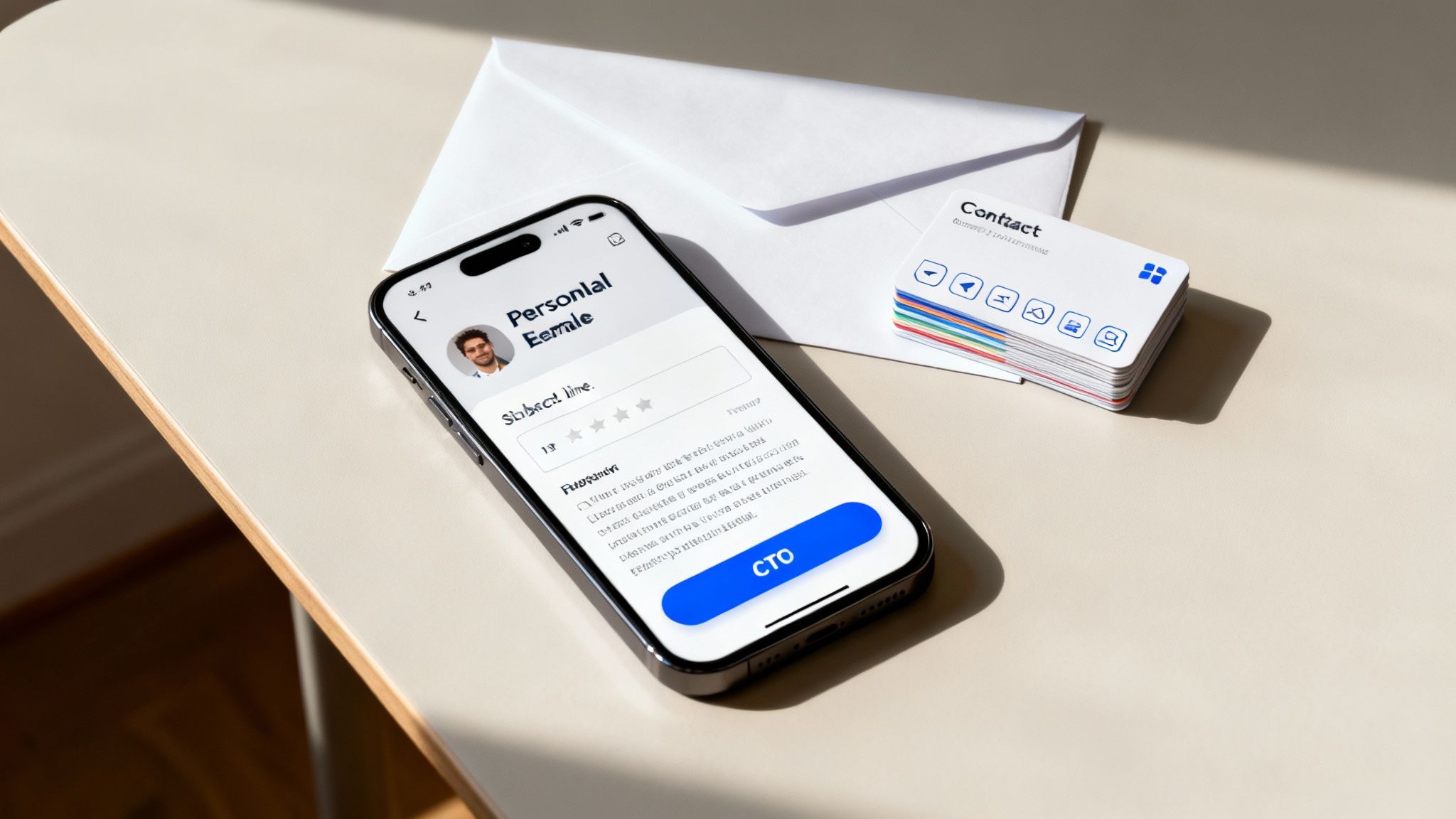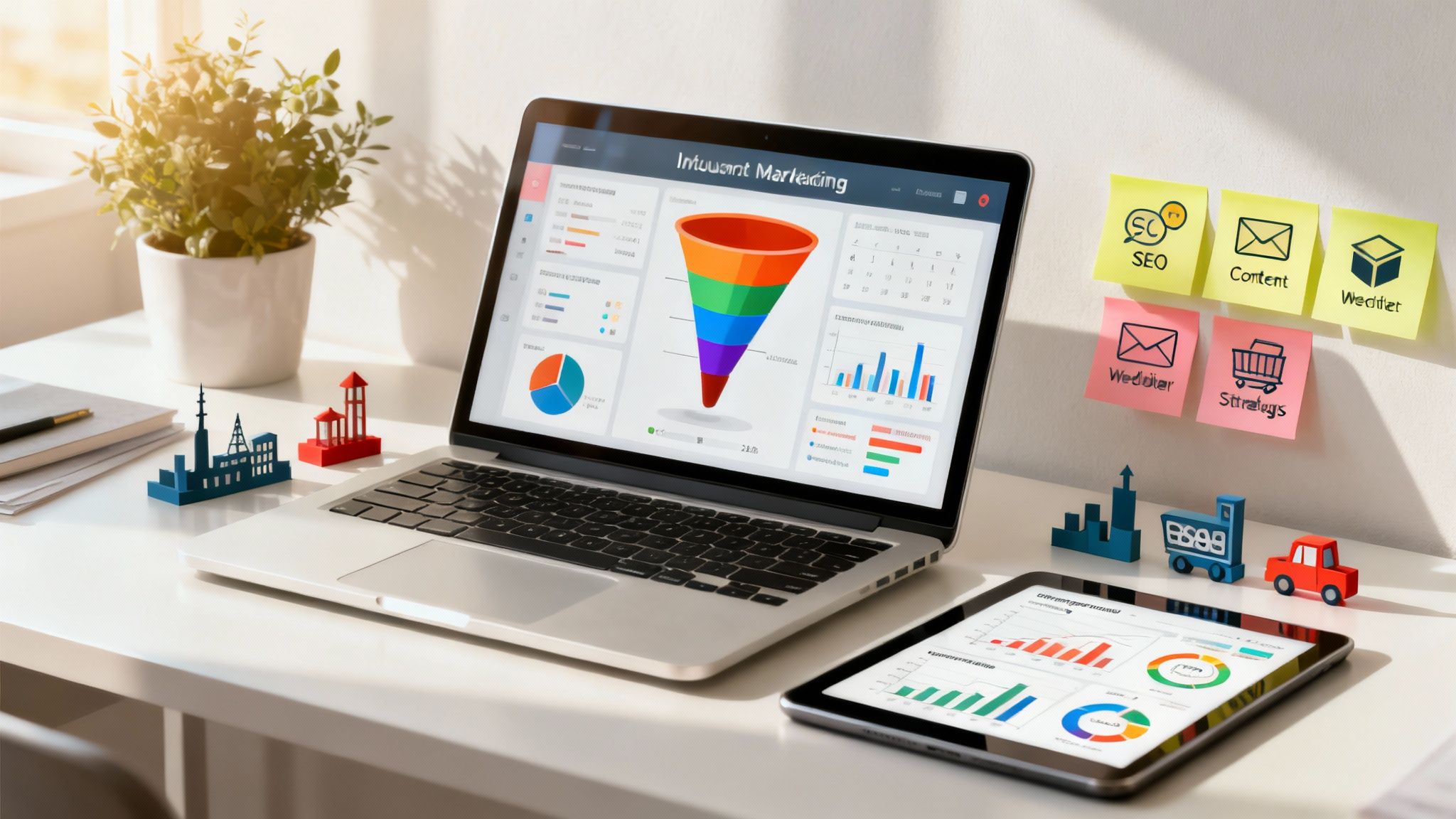In today's competitive market, attracting high-value clients requires more than disruptive advertising; it demands delivering genuine value, building trust, and fostering authentic connections. This is the fundamental premise of inbound marketing, a strategic methodology designed to pull customers toward your brand, rather than pushing your message onto them. While many marketing professionals grasp the concept, translating theory into effective, scalable execution remains a significant challenge. This is precisely why we've compiled this comprehensive collection of real-world inbound marketing examples.
This guide moves beyond surface-level case studies to provide a deep, strategic breakdown of high-performing campaigns. We will dissect the precise tactics, analyze the measurable outcomes, and offer clear, actionable steps for replication within your own organization. You are not just getting a list; you are getting a playbook.
Inside, you will see exactly how leading B2B SaaS companies, innovative eCommerce brands, and specialized professional services firms use a sophisticated mix of content, SEO, and marketing automation to build powerful, sustainable growth engines. We will explore everything from sophisticated email nurturing sequences that convert leads to SEO-driven content hubs that dominate search results. Each example is a masterclass in turning attraction into acquisition. Prepare to see how the best in the business transform their marketing from an engine of interruption into a magnet for ideal customers.
1. Blog Posts and Content Marketing
Blog posts are the cornerstone of many successful inbound marketing examples. This strategy involves creating and distributing valuable, relevant, and consistent written content to attract and retain a clearly defined audience. By addressing specific pain points, questions, and interests, businesses can draw in potential customers organically through search engines and social sharing, establishing themselves as trusted industry authorities.

The core principle is simple: provide solutions, not sales pitches. A well-executed blog becomes a powerful asset that generates qualified leads long after publication. For instance, HubSpot's blog is a masterclass in this approach, covering every conceivable marketing, sales, and service topic. Similarly, Shopify's blog educates entrepreneurs on starting and growing an ecommerce business, directly aligning content with their product's value proposition. This educational approach builds trust and keeps the brand top-of-mind.
Strategic Application and Replication
To effectively implement this strategy, focus on creating content clusters around core business offerings. A pillar page provides a comprehensive overview of a broad topic, while cluster posts delve into specific sub-topics, all linking back to the main pillar. This structure signals topical authority to search engines and improves user experience.
Key Takeaway: The goal isn't just to attract traffic but to attract the right traffic. Your content should act as a filter, drawing in prospects who are a perfect fit for your services or products by addressing their specific challenges.
Actionable Steps:
- Keyword Research: Identify long-tail keywords that your target audience uses when searching for solutions. Tools like Ahrefs or Semrush are invaluable here.
- Content Calendar: Plan and maintain a consistent publishing schedule (e.g., 2-4 posts per month) to build momentum and audience expectation.
- On-Page SEO: Optimize every post with a clear title, meta description, internal links to other relevant content, and optimized images.
- Promotion: Share new articles across social media channels and with your email list to amplify reach beyond organic search.
By following these fundamental content marketing best practices, you can transform your blog into a reliable lead-generation engine. For a deeper dive, explore these content marketing best practices from twelverays.agency.
2. Email Marketing Campaigns
Email marketing is a powerful inbound channel that nurtures relationships through targeted communication. This strategy involves sending valuable, relevant content directly to segmented subscriber lists, guiding prospects through the buyer's journey without aggressive sales tactics. By delivering personalized information and solutions, businesses can build loyalty and stay top-of-mind, turning subscribers into customers and advocates.

The strength of email lies in its direct and personal nature. Unlike public social media posts, an email arrives in a user's private space. Leading platforms like Klaviyo and ActiveCampaign exemplify this by enabling sophisticated automation based on user behavior, such as purchase history or website activity. Similarly, ConvertKit provides creators with tools to build deep connections with their audience through value-driven newsletters and sequences. These inbound marketing examples show that success comes from treating your email list as a community, not just a distribution channel.
Strategic Application and Replication
To implement this effectively, focus on list segmentation and automation. Instead of sending generic "blasts" to everyone, divide your audience into smaller groups based on their interests, lead source, or stage in the sales funnel. Then, create automated email sequences (or workflows) that trigger based on specific actions, delivering the right message at the right time.
Key Takeaway: The primary objective of inbound email marketing is to build trust by consistently providing value. Each email should reinforce your expertise and help the subscriber, making any eventual promotional offer feel like a natural next step rather than an interruption.
Actionable Steps:
- Build Your List: Offer valuable lead magnets like ebooks, checklists, or webinar access in exchange for an email address. Never buy email lists.
- Segment Your Audience: Use tags and custom fields in your email service provider to segment subscribers by behavior, demographics, and engagement level.
- Create Nurture Sequences: Develop a welcome series for new subscribers and specific campaigns to guide leads who have downloaded a particular resource.
- Optimize and Test: A/B test your subject lines, CTAs, and send times to continuously improve open rates and click-through rates.
By adopting a strategic, value-first approach, you can transform your email list into a significant source of revenue and customer engagement. For an in-depth guide, explore these best practices for email marketing campaigns from twelverays.agency.
3. Video Content and YouTube
Video content has become a powerhouse in the inbound marketing world, leveraging visual storytelling to educate, entertain, and build deep connections with an audience. This strategy involves creating produced videos for platforms like YouTube to capture attention in a way that text-based content often cannot. By demonstrating products, sharing expertise, or telling compelling brand stories, businesses can significantly boost engagement and guide viewers through the buyer's journey.
The power of video lies in its ability to convey complex information quickly and build a human connection. A prime example is Wistia, which uses its own platform to create educational video series about marketing, establishing authority while subtly showcasing its product's capabilities. Similarly, Blendtec's "Will It Blend?" series became a viral sensation by creating entertaining, product-focused content that was inherently shareable, driving massive brand awareness and sales. These inbound marketing examples show how video can attract and convert an audience without a hard sell.
Strategic Application and Replication
To succeed with video, focus on creating content series or playlists that encourage binge-watching and build a loyal subscriber base. Each video should be treated as a long-term asset, optimized to rank in YouTube and Google search results. This transforms your channel from a simple content repository into a consistent lead-generation funnel that works for you 24/7.
Key Takeaway: Your video content strategy should prioritize value and engagement over production value. A well-structured, helpful video shot on a smartphone will always outperform a high-budget, empty-calorie production.
Actionable Steps:
- Keyword Optimization: Research what your audience is searching for on YouTube and Google. Optimize your video titles, descriptions, and tags with these keywords.
- Compelling Thumbnails: Design custom thumbnails with high-contrast colors, clear text, and engaging imagery to maximize click-through rates from search and suggestions.
- In-Video CTAs: Include clear calls-to-action (CTAs) within the first 10-15 seconds and at the end of your video, directing viewers to a landing page, a free resource, or another video.
- Content Repurposing: Repurpose your video content into blog posts, social media clips, and podcast episodes to maximize its reach and impact across different platforms.
By implementing these tactics, you can turn your YouTube channel into a core component of your inbound marketing strategy. For a more detailed guide on platform optimization, explore these YouTube SEO tips from twelverays.agency.
4. Lead Magnets and Gated Content
Lead magnets and gated content are critical conversion tools that transform anonymous website visitors into identifiable leads. This inbound marketing strategy involves offering a high-value, downloadable resource, such as an ebook, whitepaper, or template, in exchange for a user's contact information. By providing a tangible solution to a specific problem, businesses create a fair value exchange that initiates a direct relationship with potential customers.
The power of this method lies in its ability to generate highly qualified leads. For instance, SEMrush offers a free website audit tool that provides immediate, personalized value while capturing leads interested in SEO. Similarly, Unbounce provides an extensive library of landing page templates, attracting a precise audience of marketers actively looking to improve conversion rates. These examples show how a well-crafted lead magnet directly aligns with the company’s core product, ensuring the leads generated are relevant and high-intent.
Strategic Application and Replication
To successfully deploy this strategy, the offer must solve a specific, immediate problem for your target audience. The perceived value of the resource should be high enough to justify sharing personal contact details. This is not just about collecting emails; it's about starting a conversation by demonstrating your expertise and willingness to help from the very first interaction.
Key Takeaway: The quality of your lead magnet directly influences the quality of your leads. A generic offer attracts a general audience, while a specific, high-value resource attracts prospects who are actively seeking the solutions you provide.
Actionable Steps:
- Identify a Specific Problem: Pinpoint a common, urgent pain point your ideal customer faces. The more specific the problem, the more compelling the offer.
- Create a High-Value Asset: Develop a resource like a checklist, template, ebook, or whitepaper that offers a clear, actionable solution.
- Design a Dedicated Landing Page: Build a focused landing page with a compelling headline, a preview of the asset, and a simple form. Discover more about creating high-converting pages with these landing page design best practices from twelverays.agency.
- Implement an Email Nurture Sequence: Immediately follow up with an automated email series that delivers the asset and guides the new lead further down the funnel.
5. Webinars and Virtual Events
Webinars and virtual events are dynamic inbound marketing examples that leverage live or on-demand video presentations to educate, engage, and convert a target audience. This strategy excels at demonstrating expertise in real-time, allowing businesses to connect directly with prospects, answer questions, and build a sense of community around their brand. It's a powerful way to capture high-intent leads who are actively seeking in-depth knowledge.
By offering valuable, educational content in an interactive format, companies position themselves as thought leaders and trusted advisors. For instance, Marketo’s webinar series on account-based marketing (ABM) provides deep, actionable insights for B2B marketers, directly aligning with their automation software's core function. Similarly, Neil Patel’s 'Advanced SEO' sessions attract thousands of digital marketers eager to learn from a recognized expert, generating highly qualified leads for his consulting and software services.
Strategic Application and Replication
To successfully use webinars, focus on topics that solve a specific, high-value problem for your ideal customer. The format allows for a deeper dive than a blog post, making it perfect for product demonstrations, technical deep dives, or expert panel discussions. The lead data captured, such as attendee engagement and questions asked, can be directly integrated into a CRM like Salesforce or Dynamics 365 for targeted sales follow-up.
Key Takeaway: The power of a webinar lies in its immediacy and interactivity. It's a unique opportunity to build a direct relationship with hundreds of prospects at once, transforming a passive audience into engaged potential customers.
Actionable Steps:
- Topic Selection: Identify pressing customer pain points or high-intent keywords to create a compelling webinar title and agenda.
- Promotion: Begin promoting your event 3-4 weeks in advance across email, social media, and paid channels to maximize registration. Send reminders 1 week, 1 day, and 1 hour before the event.
- Engagement Strategy: Plan interactive elements like live polls, Q&A sessions, and multiple calls-to-action (CTAs) throughout the presentation to keep the audience engaged.
- Post-Event Nurturing: Send the recording to all registrants and create a separate email drip campaign for no-shows. Follow up with attendees with a special offer within 24 hours to drive conversions.
By treating webinars as a multi-stage campaign, you can maximize lead generation and build a valuable library of on-demand content. Selecting the right platform is crucial for a smooth experience; you can discover some of the best virtual meeting tools on twelverays.agency to get started.
6. Social Media Marketing and Community Building
Social media marketing, within the inbound framework, transcends simple broadcasting. It is the strategic use of social platforms to build vibrant communities, distribute valuable content, and engage directly with an audience. Rather than pushing sales messages, this approach pulls prospects in by fostering relationships and creating a space for genuine conversation, effectively turning followers into brand advocates.
The goal is to become an integral part of your audience's daily digital life, not an interruption. Excellent inbound marketing examples include Glossier's Instagram strategy, which built a cult following by prioritizing user-generated content, and Buffer's blog, which uses social media to amplify its message of workplace transparency. These brands don’t just post; they interact, listen, and build movements around their products, demonstrating how powerful an engaged community can be for long-term growth.
Strategic Application and Replication
Effective social media for inbound marketing requires a focus on value exchange. Your content should educate, entertain, or inspire before it ever attempts to sell. This means understanding the unique culture of each platform and tailoring your content to fit, whether it's an insightful LinkedIn article for a B2B audience or a behind-the-scenes Instagram Story for B2C consumers.
Key Takeaway: Treat social media as a two-way conversation, not a megaphone. Your objective is to build a loyal community that trusts your brand, which naturally leads to conversions and referrals down the line.
Actionable Steps:
- Platform Selection: Focus on 2-3 platforms where your ideal customers are most active and engaged. Don't spread your resources too thin.
- Content Mix: Plan a content calendar that balances promotional posts with educational, entertaining, and user-generated content (e.g., the 80/20 rule).
- Engagement Protocol: Set a clear process for responding to comments and messages promptly and authentically. Make your audience feel heard.
- Community Building: Launch initiatives like Q&A sessions, user-generated content campaigns, or exclusive groups to foster a sense of belonging.
By prioritizing authentic engagement over vanity metrics, you can transform social channels into powerful inbound marketing assets that nurture leads and build lasting brand loyalty. To learn more, check out Sprout Social's insights on building a social media community.
7. Search Engine Optimization (SEO)
Search Engine Optimization (SEO) is the foundational practice of increasing the quantity and quality of traffic to your website through organic search engine results. It involves a mix of technical, on-page, and off-page strategies designed to make your content more visible and appealing to search engines like Google. By optimizing for keywords and search intent, businesses can attract highly qualified prospects actively looking for the solutions they offer.

This strategy is one of the most powerful inbound marketing examples because it captures demand that already exists. For instance, Backlinko, founded by Brian Dean, built an entire brand by creating in-depth SEO case studies and guides that rank for highly competitive terms. Similarly, Ahrefs uses its own tool to identify content gaps and create definitive resources that attract its ideal customer base: SEO professionals. These companies don't just sell SEO tools; they demonstrate their expertise by dominating search results.
Strategic Application and Replication
Effective SEO goes beyond just targeting keywords; it's about establishing topical authority. This involves creating comprehensive content clusters that cover a subject from every angle, signaling to search engines that you are a definitive source of information. This approach not only improves rankings but also guides users through a journey from awareness to consideration, nurturing them with valuable information.
Key Takeaway: SEO is a long-term investment in your brand's digital real estate. The goal is to build a sustainable source of organic traffic that consistently brings in qualified leads without ongoing ad spend.
Actionable Steps:
- Keyword Research: Use tools like Ahrefs or Semrush to identify long-tail keywords with high purchase intent and lower competition.
- On-Page SEO: Optimize title tags, meta descriptions, headers, and content to align with user search intent and target keywords.
- Technical SEO: Ensure your site is fast, mobile-friendly, and crawlable by addressing Core Web Vitals and site architecture issues.
- Link Building: Earn high-quality backlinks from authoritative and relevant websites to build your domain's credibility and authority.
By systematically addressing these core pillars of SEO, you can turn your website into a powerful magnet for your ideal customers. For more advanced strategies, explore this in-depth guide to B2B SEO from backlinko.com.
8. Case Studies and Testimonials
Case studies and testimonials are powerful forms of social proof that transform customer success into a compelling inbound marketing asset. This strategy involves documenting and showcasing real-world examples of how your product or service solved a specific problem for a client, thereby building credibility and trust with prospective customers. It moves beyond claims to provide tangible evidence of value.
The goal is to let your satisfied customers become your most effective salespeople. By telling their stories, you help prospects in the consideration and decision stages of the buyer's journey visualize their own potential success. Salesforce has built an empire on its customer success stories, featuring detailed accounts from various industries and company sizes. Likewise, Slack's customer stories go deep into the "before and after" of implementation, highlighting specific productivity gains and communication improvements that resonate with their target audience.
Strategic Application and Replication
To create impactful case studies, structure them as a narrative following the classic problem-solution-result framework. This storytelling approach makes complex results easily digestible and relatable. Focus on quantifiable metrics, as hard data provides the most persuasive evidence. Featuring the customer's name, photo, and company adds an essential layer of authenticity to the story.
Key Takeaway: Your best case studies address a specific objection or pain point your sales team frequently encounters. By proactively providing a real-world success story that counters that doubt, you arm your prospects with the confidence needed to move forward.
Actionable Steps:
- Identify Champions: Work with your sales and customer success teams to identify happy clients who have achieved impressive results.
- Structure the Story: Use a template to outline the customer's initial challenge, the solution you provided, and the measurable outcomes (e.g., "30% increase in lead conversion").
- Gather Quotes & Data: Interview the client to get powerful, authentic quotes and specific data points that illustrate the impact.
- Repurpose Content: Create multiple formats from one story. A detailed PDF can be turned into a webpage, a short video testimonial, social media graphics, and slides for your sales deck.
By systematically documenting and promoting customer successes, you create a library of powerful inbound marketing examples that validate your claims and accelerate the sales cycle. To see how to structure these effectively, check out these case study templates from HubSpot.
9. Infographics and Visual Content
Infographics are a powerful inbound marketing tool, transforming complex data, concepts, and statistics into easily digestible and highly shareable visual formats. This strategy leverages the brain's natural ability to process images faster than text, making it perfect for capturing attention in a crowded digital landscape. By presenting valuable information visually, businesses can boost engagement, increase brand visibility, and build backlinks from other authoritative sites.
The goal is to simplify and educate. Well-designed infographics act as standalone assets that communicate a story or key takeaways at a glance. For instance, Neil Patel frequently uses data-rich infographics to break down intricate SEO and marketing topics, making his content exceptionally linkable. Similarly, Venngage not only provides infographic templates but also uses them in its own content marketing to demonstrate their product's value and share industry trends, a classic example of practicing what you preach.
Strategic Application and Replication
To leverage this strategy, anchor your infographic's topic in original research or a unique compilation of compelling industry data. This originality is what makes it a valuable asset others will want to reference and share. Frame the visual narrative around a single, cohesive idea, guiding the viewer through a logical flow from a problem or question to a data-backed conclusion.
Key Takeaway: An infographic's primary value is its "shareability." Design it not just to inform but to be easily embedded and shared, turning your audience and industry peers into brand advocates who amplify your reach.
Actionable Steps:
- Data Compilation: Gather compelling statistics, original research, or process steps that tell a clear story. Cite all sources to build credibility.
- Design for Clarity: Use a clean layout, a consistent color palette aligned with your brand, and clear typography. Tools like Piktochart or Canva can simplify this process.
- Optimize for Sharing: Create a dedicated landing page or blog post for your infographic. Include social sharing buttons and a ready-to-copy embed code.
- Strategic Promotion: Pitch your infographic to relevant industry blogs, journalists, and partners, highlighting the unique data it offers them for their own content.
10. Podcasts and Audio Content
Podcasts are a powerful form of inbound marketing, offering serialized audio content that builds a loyal, engaged audience. This strategy involves creating valuable audio episodes focused on industry topics, expert interviews, or compelling storytelling. Because listeners can tune in during commutes, workouts, or daily chores, podcasts create an intimate and convenient way to deliver expertise, establishing deep brand affinity and authority over time.
The power of audio lies in its ability to connect on a personal level. It's not about a hard sell; it's about becoming a trusted voice in your industry. For example, HubSpot's Marketing Against the Grain offers counterintuitive marketing insights, reinforcing its brand as a thought leader. Similarly, Amy Porterfield's Online Marketing Made Easy provides actionable business advice that naturally aligns with her digital course offerings, attracting her ideal customer base through pure value.
Strategic Application and Replication
To launch a successful podcast, focus on a well-defined niche where you can become the go-to resource. Consistency is paramount; a regular publishing schedule builds anticipation and integrates your show into your listeners' routines. The format should align with your strengths, whether that's solo-hosted deep dives, dynamic co-hosted discussions, or insightful guest interviews.
Key Takeaway: A podcast isn't just content; it's a relationship. By consistently delivering valuable audio, you earn a dedicated space in your audience's weekly life, making your brand the first they think of when a relevant need arises.
Actionable Steps:
- Define Your Niche: Select a specific topic you can own. A focused podcast on "cybersecurity for MSPs" is more effective than a general "tech" show.
- Invest in Quality Audio: A good microphone and basic editing software are non-negotiable. Poor audio quality is a primary reason listeners abandon a show.
- Plan Your Content: Create a content calendar with episode topics, potential guests, and key talking points to ensure a consistent flow of high-value episodes.
- Repurpose and Promote: Turn each episode into blog posts, social media clips, and quote graphics. Promote across all channels and encourage guests to share with their networks.
10 Inbound Marketing Channels Compared
Integrating Your Inbound Engine for Maximum Impact
Throughout this deep dive, we've dissected ten powerful inbound marketing examples, moving far beyond surface-level success stories. We’ve unpacked the strategic frameworks, tactical execution, and data-driven decisions that transform a simple blog post or webinar into a predictable revenue-generating asset. The common thread weaving through every successful campaign is integration.
Inbound marketing isn’t about picking a single tactic from a list; it’s about architecting a cohesive, multi-channel engine. A well-optimized blog post (SEO) fuels a lead magnet, which in turn feeds an email nurturing sequence. A compelling webinar is amplified through social media communities, and its success is later proven with detailed case studies. This interconnected approach creates a self-sustaining growth flywheel, where each component strengthens the next.
From Disparate Tactics to a Unified Strategy
The journey from executing random acts of marketing to building a strategic inbound machine requires a fundamental shift in perspective. Instead of viewing your content, SEO, and email efforts as separate silos, you must see them as interlocking gears.
- Content as the Core: Your blog posts, videos, and podcasts are not just content; they are the fuel. They answer your ideal customer's most pressing questions, establishing your authority and attracting organic traffic.
- Conversion as the Catalyst: Lead magnets, webinars, and gated resources are the conversion points. They turn anonymous visitors into known leads by offering high-value, specific solutions in exchange for contact information.
- Nurturing as the Relationship-Builder: Email sequences and community engagement are where you build trust. You guide leads through their buyer's journey, providing timely, relevant information that positions you as the obvious choice when they're ready to buy.
- Data as the Compass: A robust CRM integration, such as connecting your marketing automation platform to Salesforce or Dynamics 365, is non-negotiable. It provides the single source of truth needed for accurate attribution, allowing you to see which inbound marketing examples and channels are truly driving pipeline and revenue. This data empowers you to double down on what works and optimize what doesn't.
Your Actionable Path Forward
Seeing these sophisticated inbound marketing examples can feel overwhelming, but implementation doesn't have to be. The key is to start small, master one component, and then layer on the next.
- Identify Your Biggest Gap: Where is your current marketing weakest? Is it attracting top-of-funnel traffic, converting that traffic into leads, or nurturing those leads into sales opportunities?
- Choose One Strategy to Master: Select one of the examples from this article that directly addresses your biggest gap. If you need traffic, focus on creating a pillar page and topic cluster strategy (SEO). If you need leads, develop a high-value lead magnet and a simple landing page.
- Build and Measure: Implement the strategy from start to finish. Define your KPIs upfront, track your progress closely, and don't be afraid to iterate based on the data.
- Integrate and Expand: Once you have a proven, repeatable process for one channel, connect it to the next logical step. If your lead magnet is performing well, build a three-part email nurture sequence for everyone who downloads it.
By adopting this methodical, integrated approach, you move beyond mere content creation. You begin building a sophisticated marketing ecosystem that consistently attracts, engages, and delights your ideal customers, turning your marketing function from a cost center into a powerful, predictable driver of business growth.
Feeling inspired by these inbound marketing examples but unsure where to start with your own strategy? At Twelverays, we specialize in designing and executing integrated inbound engines that drive measurable growth for B2B and professional services firms. Let’s build your growth machine together.





